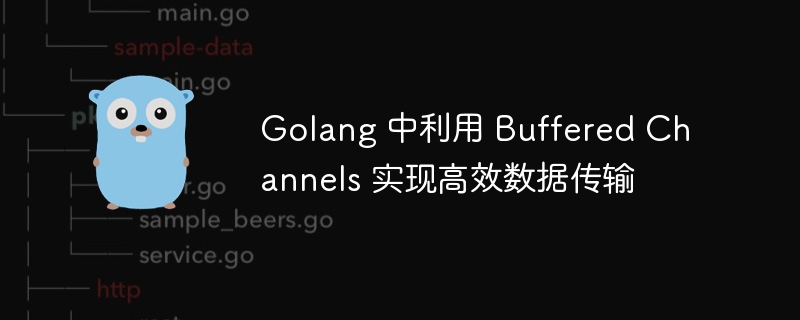

Use Buffered Channels to achieve efficient data transmission in Golang
In Golang, Channel is a very important concurrency primitive, used to coordinate between different Goroutines data communication. Buffered Channels are a special type of Channel, which has a buffer of a certain size and can improve the efficiency of data transmission to a certain extent. This article will introduce how to use Buffered Channels to achieve efficient data transmission.
First, let’s understand what Buffered Channels are. In Golang, you can create a Channel through the make() function and specify its buffer size, as shown below:
ch := make(chan int, 10)
The above code creates an integer Channel with a buffer size of 10. When sending data to this Channel, the send operation will only block when the buffer is full. When receiving data from this Channel, the receiving operation will block only when the buffer is empty. Therefore, Buffered Channels can provide a certain degree of asynchronous data transmission, improving data transmission efficiency.
Now, let’s look at a specific example. Suppose we have a producer Goroutine and a consumer Goroutine, and data is transferred between them through a Buffered Channel.
package main
import (
"fmt"
"time"
)
func producer(ch chan int) {
for i := 0; i < 10; i++ {
ch <- i // 向 Channel 发送数据
fmt.Println("Producer sends:", i)
time.Sleep(500 * time.Millisecond)
}
close(ch) // 关闭 Channel
}
func consumer(ch chan int) {
for {
data, ok := <-ch // 从 Channel 接收数据
if !ok {
break // Channel 已关闭,退出循环
}
fmt.Println("Consumer receives:", data)
}
}
func main() {
ch := make(chan int, 5) // 创建缓冲区大小为 5 的 Channel
go producer(ch)
consumer(ch)
}In the above code, we created an integer Channel with a buffer size of 5, and sent and received data in the producer Goroutine and consumer Goroutine respectively. Among them, the producer Goroutine loops to send data to the Channel and prints the sent data; the consumer Goroutine loops to receive data from the Channel and prints the received data. Finally, the producer Goroutine and consumer Goroutine are started respectively in the main function.
By running the above code, we can observe the data transmission process between the producer and the consumer. Since the buffer size of the Channel is 5, the producer will not be blocked and can continue to send data after the first 5 data are sent. The consumer will receive data from the Channel according to its own speed. When the producer sends 9, the Channel buffer is full, and the producer will be blocked. The producer cannot continue to send data until the consumer receives part of the data and there is space in the buffer.
To sum up, using Buffered Channels can improve the efficiency of data transmission to a certain extent. By setting an appropriate buffer size, you can balance the speed difference between producers and consumers and improve the ability to process data concurrently. In actual development, we can flexibly use Buffered Channels according to actual needs to achieve efficient data transmission.
Reference materials:
Original article, Please indicate the source.
The above is the detailed content of Using Buffered Channels to achieve efficient data transmission in Golang. For more information, please follow other related articles on the PHP Chinese website!
 How to define variables in golang
How to define variables in golang
 What are the data conversion methods in golang?
What are the data conversion methods in golang?
 What are the commonly used libraries in golang?
What are the commonly used libraries in golang?
 What is the difference between golang and python
What is the difference between golang and python
 What are the data collection technologies?
What are the data collection technologies?
 Regular expression tool
Regular expression tool
 The role of linux terminal commands
The role of linux terminal commands
 What currency is MULTI?
What currency is MULTI?




